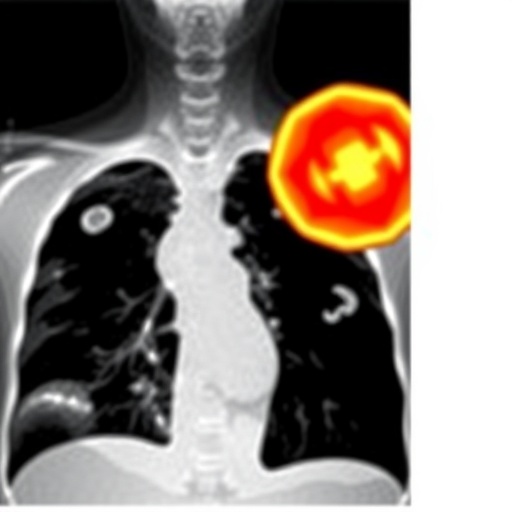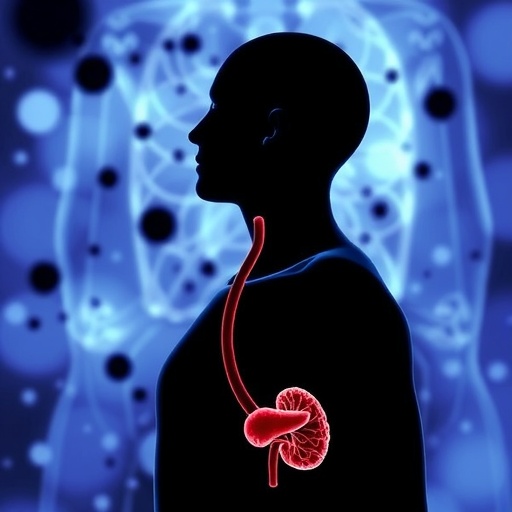In the evolving landscape of thoracic oncology diagnostics, the integration of advanced imaging modalities has become increasingly crucial for accurate assessment of mediastinal and hilar lymph nodes. A recent retrospective study, published in the Journal of Thoracic Disease, sheds new light on the diagnostic utility of endobronchial ultrasound elastography (EBUS-E) in differentiating between benign and malignant lymphadenopathy. This study delineates the capabilities and limitations of this promising technique, offering insight that could influence future clinical decision-making and research directions.
Endobronchial ultrasound elastography represents a sophisticated imaging adjunct to standard EBUS, augmenting visualization with tissue stiffness characterization. Unlike conventional imaging parameters focused solely on morphological features such as size and shape, elastography exploits the principle that malignant tissues tend to exhibit altered mechanical properties—specifically increased stiffness—compared to benign tissues. The technique measures strain resulting from applied mechanical stress, producing color-coded maps that reflect tissue elasticity, with blue areas generally indicating harder tissue.
Central to the study’s findings is the analysis of the blue color ratio (BCR), a semi-quantitative elastography index representing the proportion of elastically stiff tissue within the targeted lymph node. Previous literature has suggested the BCR’s potential as a valuable biomarker for cancer detection; however, ambivalence has persisted regarding its specificity and sensitivity across different pathologies. This study reveals that while BCR can effectively distinguish malignant from benign lymph nodes in general, its discriminatory power falters when differentiating benign nodes from those involved with small cell carcinoma, a particularly aggressive and distinctive subtype of lung cancer.
Moreover, the investigators report that the combined index of elastography grading score along with the short-axis diameter of the lymph node yielded an area under the receiver operating characteristic (ROC) curve of 0.702. This metric, while moderate, underscores that integrating morphological and elastographic data enhances diagnostic accuracy compared to either parameter alone. Nonetheless, this level of accuracy indicates that reliance on elastography as a sole diagnostic criterion remains premature.
The study further emphasizes that the pathology and anatomical location of lymph nodes significantly influence BCR values. Variations in tissue composition and surrounding structures may modify elastographic signals, potentially confounding interpretation. For instance, lymph nodes in certain mediastinal stations exhibit different stiffness characteristics, independent of their malignant or benign status. These nuances underscore the necessity for practitioners to contextualize elastography findings within the broader clinical and imaging framework.
Importantly, the authors affirm the continued primacy of invasive endobronchial ultrasound-guided transbronchial needle aspiration (EBUS-TBNA) as the standard of care for lymph node evaluation. While elastography offers a non-invasive adjunctive perspective, pathological tissue sampling remains indispensable for definitive diagnosis, particularly given the complex histological heterogeneity encountered in thoracic lymphadenopathy.
The implications for clinical practice are manifold. Elastography could refine patient selection for invasive procedures by identifying nodes with higher suspicion, thereby optimizing procedural efficiency and potentially reducing unnecessary biopsies. Furthermore, real-time elastographic feedback during EBUS-TBNA may assist operators in targeting areas within a node that exhibit the greatest stiffness, which could correlate with malignancy, theoretically increasing diagnostic yield.
Despite these encouraging prospects, the study advocates for continued research, particularly focusing on elucidating factors influencing BCR variability. Identification of underlying causes for elastography signal fluctuation—such as inflammation, fibrosis, or necrosis—would enhance interpretative fidelity. Additionally, prospective investigations incorporating larger cohorts and multicenter data are essential to validate findings and establish standardized elastography protocols.
From a technological perspective, advancements in elastographic imaging algorithms and hardware calibration will likely augment sensitivity and reproducibility. The integration of artificial intelligence and machine learning into elastography analysis holds potential for pattern recognition beyond human visual acuity, enabling more nuanced tissue characterization and risk stratification.
In conclusion, while endobronchial ultrasound elastography emerges as a compelling adjunctive tool in the armamentarium against thoracic malignancies, it remains supplementary rather than replacement technology. Its role in distinguishing malignant from benign lymph nodes shows promise but is constrained by variabilities rooted in pathology and anatomy. The future of EBUS elastography will depend heavily on rigorous clinical validation, technological refinement, and integration with multimodal diagnostic pathways. As such, it represents a frontier of investigation that could ultimately enhance diagnostic precision and patient outcomes in pulmonary oncology.
Subject of Research: People
Article Title: Diagnostic utility of endobronchial ultrasound elastography for detecting benign and malignant lymph nodes: a retrospective study
News Publication Date: 25-Feb-2025
Web References: http://dx.doi.org/10.21037/jtd-24-1042
References: Zhou X, Li Y. Diagnostic utility of endobronchial ultrasound elastography for detecting benign and malignant lymph nodes: a retrospective study. J Thorac Dis 2025;17(2):614-622. doi: 10.21037/jtd-24-1042
Keywords: Cancer, Lung cancer
Tags: advanced imaging modalities in oncologybiomarkers for cancer detectionblue color ratio in lymph nodesclinical decision-making in thoracic cancercolor-coded elastography for diagnosticsdifferentiating benign and malignant lymphadenopathyEBUS for lymph node assessmentendobronchial ultrasound elastographymechanical properties of malignant tissuesmediastinal lymph node evaluationthoracic oncology imaging techniquestissue stiffness characterization in cancer





